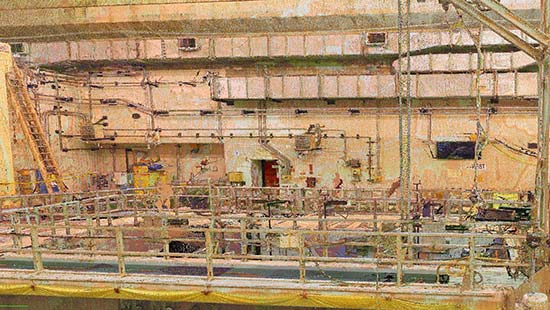What's the Point?

Sophisticated 3D images based on millions (and millions) of data points save time, money and injury risk for plants across the Valley.
Sophisticated 3D images based on millions (and millions) of data points save time, money and injury risk for plants across the Valley.
When Tracy Seiber looks at a TVA facility, he sees nothing but clouds…clouds of data, that is. As a professional land surveyor in Transmission Engineering, Seiber and his teammates work across the company creating “point clouds” of data that create a 3D view of TVA facilities.
Don’t let Seiber’s title fool you — he and his team have been doing a lot of work inside TVA’s plants lately, and are currently scanning upper containment and the refueling floor at Watts Bar Nuclear Plant. Once the scans of upper containment are complete, an area that is typically accessible only a few hours a week will be available for staff to view in the virtual world 24/7.
“The work saves labor costs, improves safety and stimulates ideas and solutions,”Seiber explains. The data allows TVA nuclear staff to conduct pre-job briefings in high-radiation areas before the doors are even breached. The team can see everywhere they’re about to go before they go inside, reducing their exposure time and safety risk.
Pushing the Envelope
That kind of detail is what excites Watts Bar Nuclear Plant’s Radiation Protection/ALARA Specialist Will Jones. Jones says the TVA nuclear fleet has spent 10 or 15 years working with different vendors on smaller projects to scan different parts of TVA’s three nuclear plants. But the firms that do the survey scans keep the data and TVA has to ask for it (and pay for access) every time they need it.
“Why not use TVA staff to do TVA work?”says Jones.
“They’re pushing the envelope on state-of-the-art technology. It’s not a lesser product at all. And we get the benefit of seeing the data across the fleet anytime we need it.”

Jones says using the scan data has been a quick easy win for all three nuclear plants in the area of valve locations. Workers can get some text about the location of the valve through Maximo, TVA’s asset-management software. But Maximo provides only text, not imagery. Using a system called TruView, workers can “see” into the actual work environment from the 3D scan output. After identifying the valve’s actual location, workers can go to the exact spot and perform their work with minimal time and reduced radiation exposure.
Seeing is Believing
TVA has had surveyors since the beginning. And the team still does “old school” surveying, including marking the boundaries for 11,000 miles of shoreline along the Tennessee River. But Seiber points out the newer techniques have multiple applications for TVA. These advanced surveying methods allow outages to flow more smoothly, for instance. The data means teams can site an installation path for equipment before it’s even fabricated. Dimensions and elevations for construction and installation of new equipment can be provided to the manufacturer, ensuring when the equipment is built and then arrives at a plant, the path is clear and its an exact fit for its new home.
 Combined scans of Unit 2 Upper Containment at Watts Bar Nuclear Plant.
Combined scans of Unit 2 Upper Containment at Watts Bar Nuclear Plant.
The team got its start with laser scanning in the plant environments, and can now provide a cost savings to TVA of one-half to one-third over an outside contractor solution. And because TVA owns the data, it can quickly and easily access it for other, similar projects.
So there’s no wonder that clients like Jones are excited:
“We want to get TVA into the 21st century and take it beyond anything we’ve done before.”Watts Bar Nuclear has plans to scan the other buildings on site and create a virtual tour for visitors to see inside the plant’s perimeter.
For Seiber, the technology is the path to the future for TVA.
“Our biggest reward is happy clients that bring us repeat business. We are the bridge to the latest technology for the best interest of TVA.”

